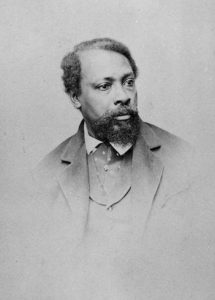
David Bowseer
*David Bowser was born on this date in 1820. He was a Black ornamental artist and portraitist.
Born in Philadelphia, Pennsylvania, David Bustill Bowser was a grandson of Cyrus Bustill, a former slave who purchased his freedom and went on to become a founding member of Philadelphia's Free African Society, and a son of oyster house proprietor Jeremiah Bowser, whose freedom had been purchased by a group of Philadelphia Quakers after he had been arrested for being a fugitive slave. He was a cousin and student of artist Robert Douglass Jr. of the Pennsylvania Academy of Fine Arts. Young Bowser also attended the private school operated by Douglass's sister, Sarah Mapps Douglass.
Married to seamstress Elizabeth Harriet Stevens Gray, Bowser, and his wife were the parents of artist Raphael Bowser and violinist and music teacher Ida Elizabeth (Bowser) Asbury. They supported their family by designing and painting banners, signs, uniform hats, and regalia for fraternal associations, political groups, and volunteer fire companies in and beyond Philadelphia. During the 1840s, Bowser painted banners for diverse clients and received a commission to paint the portrait of prominent abolitionist and real estate developer Jacob C. White. Their home became a stop on the Underground Railroad. In 1858, politics and advocacy merged with art when Bower painted the portrait of abolitionist John Brown while Brown was visiting the Bowser home. During this same period, Bowser completed his painting, The Firebell in the Night. In addition, he was also active during this phase of his life with the Grand United Order of Odd Fellows.
During the American Civil War, Bowser joined with several other prominent members of Philadelphia's Black community to begin recruiting soldiers in 1862 if the federal government permitted large numbers of Blacks to enlist following the 1863 announcement of the Emancipation Proclamation by President Abraham Lincoln. Bowser was commissioned in early 1863 to design banners and battle flags for eleven Black regiments in preparation for their respective mustering at Camp William Penn, located just outside of Philadelphia. Bowser's work on the first banner was paid for through a commission awarded by the Contraband Relief Association (CRA), an organization headed by Elizabeth Keckley, the former slave. She became Mary Todd Lincoln's dressmaker.

The CRA then presented it to the leaders of the 1st United States Colored Infantry. Concerning the other Bowser-designed battle flags, historians at the Pennsylvania Historical and Museum Commission note, "The 127th and 3rd regiments marched carrying banners reading 'We will prove ourselves men' and 'Rather Die Freemen Than Live to Be Slaves.' Beneath these, black soldiers protect white women, representing Columbia, the symbol of the republic. The 45th banner, proclaiming 'One Cause, One Country,' shows a black soldier proudly holding an American flag before a bust of George Washington as Black troops fight in the background. The 24th's banner shows a black soldier ascending a hill, his arms outstretched in prayer, beneath the words 'Let Soldiers in War, Be Citizens in Peace.'" For the 22nd USCT banner, Bowser depicted a black soldier pointing "a bayonet at the chest of a Confederate who has allowed his flag to fall and who is tossing aside his sword," beneath the words, "Sic semper tyrannis" ("thus always to tyrants"). This phrase would come to have an entirely different meaning two years later when shouted by John Wilkes Booth after he assassinates Lincoln at Ford's Theater.
In addition, Bowser was planning and presenting at several large gatherings of Blacks in Philadelphia during the summer of 1863. In 1865, Bowser also painted a portrait of Lincoln, working from an image of the president later used to create America's post-Civil War five-dollar bill. In 1867, he was appointed by the leadership of the Pennsylvania Equal Rights League, with William D. Forten and Octavius V. Catto, to represent the League in securing "passage of a bill through the Legislature forbidding the exclusion of persons from public conveyances" anywhere in Pennsylvania "on account of race or color." They were successful.
On April 26, 1870, he was selected to preside over the "jubilee procession" and "mass meeting" at Philadelphia's Horticultural Hall. As vice president of the Pennsylvania Equal Rights League, Bowser was also among those who motivated the organization's membership to meet with President Grant at the White House on November 26, 1872, "for the purpose ... of urging upon him the importance of recommending in his annual message to Congress, a request kindred to the 'Fifteenth Amendment,' In 1875, Bowser sued Alfred L. Jones of Baltimore was in court for violating his patent for a chromolithographic image that he (Bowser) had designed for the Odd Fellows. Bowser was an artist whose "works were the first widely viewed, positive images of Blacks painted by a Black," according to historians at the Pennsylvania Historical and Museum Commission.
Politically active throughout much of his adult life, he also helped to secure the post-war passage of key civil rights legislation in Pennsylvania. David Bowser died in Philadelphia on June 30, 1900, and was buried at the Eden Cemetery in Collingdale, Pennsylvania. During the 1940s, a significant portion of his legacy was nearly obscured forever when the original Civil War battle flags he had designed were removed from the military museum at West Point, where they had been stored since the War. After the flags were thrown away, all that remained were the seven images described above (under "American Civil War").